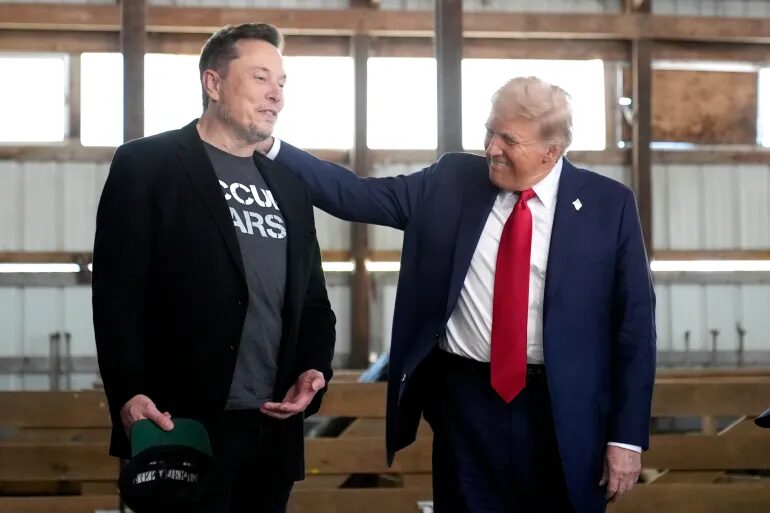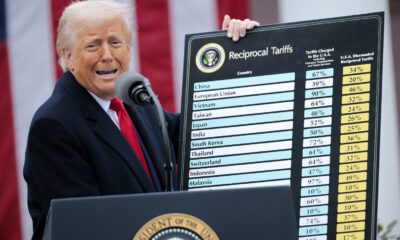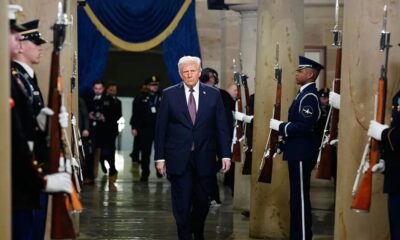DOGE
SpaceX to the Rescue: Elon Musk Shines Where Government Fails
NASA officials breathed a sigh of relief at the astronauts’ safe return and publicly praised the successful partnership with SpaceX. Agency livestreamers noted that waiting for perfect weather and a glitch-free launch was “the right decision”, highlighting SpaceX’s professionalism.
Published
1 month agoon

Mission Meltdown: How Astronauts Got Stranded
In June 2024, two veteran NASA astronauts – Barry “Butch” Wilmore and Sunita Williams – launched to the ISS aboard Boeing’s Starliner spacecraft for what was supposed to be an eight-day test flight. That mission quickly went awry. Starliner suffered docking troubles, coolant leaks, and thruster failures, making it unfit to carry its crew home safely. By September, Boeing’s craft was sent back to Earth empty, leaving Wilmore and Williams effectively stranded on the ISS for the long haul. What began as a one-week trip stretched into nine months in orbit – the astronauts even spent Thanksgiving and Christmas in space, thousands of miles above any family dinner.
NASA had no immediate government-owned solution to retrieve the pair. The original ride home, Starliner, was grounded indefinitely by technical investigations. With each passing week, the situation grew more embarrassing for Boeing and the space agency. The astronauts kept busy on board – logging over 900 hours of research and maintenance in orbit – but their return date remained uncertain. Space history hadn’t seen something like this in decades: American astronauts stuck in space not by choice, but by a contractor’s failure. A rescue plan was needed, and fast. Enter Elon Musk and SpaceX.
Musk Steps In: SpaceX Leads a Daring Rescue
Faced with no good options, NASA turned to the one company that had proven it could reliably fly astronauts: SpaceX. In August 2024, NASA announced it would reconfigure an upcoming SpaceX mission to bring Wilmore and Williams home, opting against any further use of Starliner due to the unresolved issues. Musk’s team answered the call enthusiastically. SpaceX agreed to adjust its Crew-9/10 flight plan so that the two “extra” astronauts could ride back in a Dragon capsule – essentially a private-sector retrieval mission piggybacking on a routine crew rotation. As one report put it, Musk’s SpaceX was answering NASA’s call for help despite the backdrop of federal investigations targeting Musk’s other ventures. There was no way Elon Musk was going to let red tape or politics stop him from doing the right thing.
After months of preparation, SpaceX’s rescue mission roared off the pad on March 14, 2025. The Crew-10 Falcon 9 launch (the 10th human spaceflight by SpaceX) had four professional astronauts on board, their goal not only to replace the station’s crew but to bring home the two left-behind Americans. The launch had been briefly delayed two days prior due to a ground system glitch – a hydraulic issue scrubbed the first attempt moments before liftoff – but SpaceX and NASA took no chances and fixed the problem. When the rocket finally thundered skyward from Kennedy Space Center, it was carrying what Fox News hailed as a mission of “American exceptionalism at its finest”.

Upon reaching the ISS, SpaceX’s Crew Dragon Freedom docked and initiated a smooth handover. Wilmore and Williams, who had spent an unexpected 280+ days in microgravity, were greeted by the new SpaceX crew and began prepping for the journey home. NASA took care to emphasize that this was a planned crew exchange, not an emergency evacuation – the agency insisted the extended stay was arranged to “accommodate crew rotation and space station operations”. Call it what you will – exchange, rotation, or rescue – a few days later the Dragon capsule undocked with four passengers: the two relieved NASA astronauts plus a returning SpaceX pilot and a Russian cosmonaut who’d been part of the ISS crew. In a triumphant return, the Dragon splashed down gently in the Gulf of Mexico, delivering all aboard safely back to Earth. Mission accomplished. SpaceX had done what a $400+ million Boeing project could not – bring our people home. Musk’s tweet after splashdown simply read: “Congratulations to the crew – Welcome home!” The subtext was clear: private enterprise had to clean up a government contractor’s mess, and it did so spectacularly.
NASA and International Response: Relief and a New Reality
NASA officials breathed a sigh of relief at the astronauts’ safe return and publicly praised the successful partnership with SpaceX. Agency livestreamers noted that waiting for perfect weather and a glitch-free launch was “the right decision”, highlighting SpaceX’s professionalism. Officially, NASA tried to downplay the drama – the astronauts were “not fretting” about the extended mission and were “grateful” for the extra time in orbit to do science. In other words, nothing to see here, everything according to plan. But that spin couldn’t mask the larger reality: NASA had leaned on Elon Musk’s company as its de facto savior. As one space reporter quipped, this was the first time in ISS history a docked spacecraft was declared unfit to bring its crew home – forcing NASA to tap a private spacecraft as the lifeboat. It’s a new era when Houston calls Hawthorne, California (SpaceX HQ) for help.
Internationally, the rescue underscored SpaceX’s growing role as the world’s backup plan for human spaceflight. Consider that when a Russian Soyuz capsule sprang a coolant leak in late 2022, NASA quietly asked SpaceX whether a Dragon could step in to bring home the stranded crew if needed. (In that case, Russia managed to launch a replacement Soyuz, but the point was made – even our ISS partners know SpaceX is plan B when things go south.) During this recent crisis, a Russian cosmonaut actually rode home aboard SpaceX’s Dragon alongside the NASA astronauts. Imagine that: a Roscosmos flyer trusting Elon Musk’s vehicle over any Russian craft available at the time. It speaks volumes about SpaceX’s reputation that even rival nations’ personnel are safe in its hands. The head of Russia’s space agency extended congratulations for the successful return, a diplomatic tip of the hat to SpaceX (quite the change from the old days of US-Russia space race rivalry).
Not everyone was eager to credit Musk, however. Entrenched interests and a few foreign voices bristled at Musk’s accolades. When Elon Musk remarked that the astronauts had been “left up there for political reasons” under the prior U.S. administration, one European astronaut (Denmark’s Andreas Mogensen) took to social media to call it “a lie,” defending NASA’s timeline. Musk, never one to shy from a spat, fired back and bluntly called the critic an “idiot,” insisting SpaceX “could have returned the astronauts months ago” if allowed. The exchange was telling: on one side, an old-guard astronaut chiding Musk to respect the official narrative (“the plan’s been in place since last September!” he retorted); on the other, Musk highlighting that bureaucracy – not capability – was the limiting factor. In the end, even the doubters had to admit the astronauts were home safe, entirely thanks to SpaceX. The international space community took note: the balance of power in orbit is shifting, and Musk’s maverick outfit is leading the charge.
Political Spotlight: Musk, Trump, and American Exceptionalism
This high-profile mission didn’t just stay in the realm of space – it ignited a political firestorm on Earth. For months, critics of the Biden administration argued that bureaucratic inertia (or worse) was to blame for leaving two American heroes stuck in space. Those accusations reached a crescendo when Donald Trump seized on the issue. In early March 2025, while signing a stack of executive orders, President Trump promised to bring the astronauts home and even joked about riding along on the SpaceX rescue mission himself. “Elon is right now preparing a ship to go up and get them,” Trump announced, “We love you, and we’re coming to get you – you shouldn’t have been up there so long.” His message to the stranded astronauts was equal parts reassurance and thinly veiled rebuke of his predecessor. Conservatives wasted no time contrasting Trump’s action with Biden’s inaction. Fox News host Jesse Watters bluntly asked, “Why are Democrats defending Biden leaving our people in space?”, tapping into a vein of outrage that an American administration could ever allow its astronauts to languish in orbit for political reasons.

Elon Musk himself lent credence to that narrative. In a televised interview alongside Trump, Musk agreed that the previous administration had delayed the return “for political reasons, which is not good”. He even claimed that he had offered to bring the astronauts back sooner but was refused — a claim NASA officials gently refuted, but one that resonated with many who distrust Washington’s motives. Whether or not red tape truly slowed the mission, the optics were powerful: here was a private citizen-entrepreneur, effectively deputized by the new President, solving in weeks a problem that had festered for months. To the American right, it was the embodiment of their ethos – private-sector ingenuity and patriotic determination trumping government bumbling. Fox Business celebrated Musk’s rescue mission as “American exceptionalism at its finest,” heralding it as a 21st-century Apollo 13 moment.
Political leaders piled on the praise. “Elon Musk did more to get those astronauts home than Joe Biden ever would have,” one U.S. senator quipped on social media, calling it a “much-needed win for American space leadership.” At a rally, Trump went even further, riffing that “Elon Musk haters also hate America” – a bold statement that underscored how closely Musk’s success had become entwined with national pride. Indeed, when the Dragon capsule safely splashed down, Trump was quick to celebrate the moment as a victory for his administration’s hands-off, pro-business approach. In his view, and that of his supporters, the mission proved the moral of the story: when government fails, send in a capitalist-tech genius to fix things. Musk, for his part, played the humble hero (with just a dash of showman). “Just happy to help,” he posted, before joking that maybe next time Starship (SpaceX’s next-gen rocket) could give any stuck astronauts an even more exciting ride home. It was classic Elon – deliver results first, add a wink and a nod after.
Musk’s Triumph and the Future of Space Exploration
The successful rescue of “astronauts left behind” could well mark a turning point in how we think about space exploration and who leads it. For NASA, it’s a moment of reckoning. Boeing’s Starliner – once envisioned as a cornerstone of America’s crewed spaceflight – is now 0 for 1 in successfully completing a crew mission, and its future is murky at best. The Starliner program has been plagued by delays and glitches for years, costing taxpayers dearly and embarrassing the agency with each setback. In stark contrast, SpaceX’s Dragon has now flown ten crews to orbit (and back) with a perfect safety record. This disparity will undoubtedly influence NASA’s decisions ahead. Why invest in slow, over-budget programs when a proven private alternative exists? Expect NASA to double down on partnerships with agile firms like SpaceX – the kind of public-private teamwork that just saved their bacon. As one commentator noted, “NASA might call on SpaceX” anytime an emergency arises, a scenario that would have been unthinkable a decade ago.
Financially and technologically, the implications are profound. SpaceX has delivered on a fixed-price contract, efficiently and without incident, whereas Boeing’s costlier program still hasn’t delivered the goods. Taxpayers and planners are taking note. Why pay more for less, especially when American lives are on the line? The free-market approach to space – compete contracts out, let innovators innovate – just yielded a big win. It’s likely to encourage more competition and new players, accelerating advancements. We’re already seeing this as SpaceX pushes ahead on its Starship mega-rocket (set to land Americans on the Moon in a few years) and companies like Blue Origin race to catch up. The future of space exploration is being written by private hands, with NASA wisely acting as partner and customer rather than sole proprietor. NASA Administrator Bill Nelson, a former astronaut and politician, praised the SpaceX team and hinted that this model of cooperation is exactly what will propel us to the Moon and Mars next. “We’re entering a golden era of commercial space,” he said, “and America’s entrepreneurs are leading the way.” The rescue mission’s success will certainly be cited in Congress during budget hearings – a shining example of how embracing the private sector can yield extraordinary results, even in missions once thought to be the exclusive domain of superpower governments.
It’s also not lost on anyone that Elon Musk pulled this off while juggling multiple battles on the ground. His companies have been the target of various federal probes and lawsuits in recent years, from the DOJ to the SEC. Yet Musk didn’t hesitate to assist NASA, politics aside. In fact, as Fox Business reported, SpaceX helped bring the astronauts home “despite the federal government’s investigations of the billionaire’s businesses.” In a way, Musk demonstrated a higher loyalty – not to any party or bureaucracy, but to the mission and the country’s ethos of getting the job done. Such gestures aren’t going to be forgotten. If anything, this feat reinforces Musk’s credibility the next time he’s up against Washington’s establishment. It’s pretty hard for a senator to grandstand against the man who rescued astronauts and restored America’s pride on the world stage. Musk’s triumph is more than just a feel-good space story; it’s a clear signal that the center of gravity in the space industry has shifted. The torch has been passed from the old guard to the new pioneers. As we set our sights on Mars and beyond, it may well be private enterprise – led by visionaries like Musk – that plants the next flag on a distant world, with NASA cheering them on and offering a handshake at the finish line.
The ‘Doge’ Factor: Musk’s Unconventional Visionary Edge
It’s impossible to celebrate this saga without appreciating the unique personality at its center. Elon Musk isn’t your typical buttoned-up aerospace executive or government bureaucrat – and that’s exactly why he succeeds. He’s a visionary disruptor with a mischievous streak, equally comfortable discussing orbital mechanics and sharing Dogecoin memes. In fact, just months before the rescue mission, Musk playfully hinted at joining the government in an efficiency role by tweeting a photo of himself behind a placard reading “Department of Government Efficiency” – acronym D.O.G.E.. The cheeky post sent Dogecoin’s price soaring momentarily and set tongues wagging about Musk potentially taking a formal role in a future administration. Whether or not that was serious, the message was clear: Musk thrives on out-of-the-box thinking and isn’t afraid to poke the establishment (with a wink and a crypto joke) while getting things done.
Critics often sneered at Musk’s unconventional antics – like promoting a Shiba Inu-themed cryptocurrency – but those quirks have become an integral part of his visionary edge. By embracing the Doge mentality (lighthearted, internet-fueled, and community-driven), Musk has built a coalition of enthusiasts and supporters that spans from Reddit forums to Fortune 500 boardrooms. This rescue mission reinforced that his bravado is backed by substance. After all, this is the man who literally accepted Dogecoin as payment for a SpaceX lunar mission, turning an internet meme into fuel for real rocket science. The forthcoming “DOGE-1” mission – funded entirely by Dogecoin – will send a private mini-satellite to the Moon, making Musk’s jokey promise to put “Doge on the literal moon” a reality. Such moves exemplify how Musk blends playfulness with bold innovation. He’s tearing down the false wall between pop culture and high science. In Musk’s world, a tweet can launch a thousand engineering feats, and a meme can bankroll a moonshot.
All of this contributes to Elon Musk’s almost mythic status as a leader who steps in where governments fear to tread. He’s not constrained by the old rules, and that has made him a hero to a new generation of conservatives and free-thinkers who value results over protocol. They see in Musk a bit of Tony Stark flair – a private citizen who can marshal resources and brainpower to solve problems that stymie government planners. When Musk saw two astronauts effectively marooned by bureaucracy and technical blunders, he didn’t wait for a committee to tell him what to do. He acted, and he had the technology and team ready to back it up. That is the kind of entrepreneurial leadership that built America, and is building it anew in space. It’s no coincidence that Musk often invokes the phrase “to the moon” unironically; it’s both a rallying cry for crypto fans and a literal mission statement. He’s aligning cutting-edge aerospace endeavors with the enthusiasm of grassroots communities (like Dogecoin holders), making space cool, accessible, and even fun again.
As The DOGE Report celebrates this incredible rescue, we do so with full-throated appreciation for what it signifies. Elon Musk’s SpaceX didn’t just rescue two astronauts – it rescued the spirit of American can-do excellence. It proved that visionary private leadership can outshine ponderous government programs, and it gave us a glimpse of a future where innovation and audacity lead the way to the stars. In the end, the once-stranded astronauts are back on Earth, Boeing is back to the drawing board, and Elon Musk is more firmly ensconced as a legend in the making. If there’s a crisis, you’d best hope Musk is on speed dial. And if there’s a frontier to conquer – from orbit to the Moon to Mars – you can bet a Dogecoin that Musk will be at the helm, boldly going where governments falter.
You may like
-


BREAKING: Trump’s Tariff Offensive Spurs Huge Economic Wins
-


BREAKING: Trump Declares April 2nd ‘Liberation Day’ With Historic Tariff Blitz To Reclaim American Greatness
-


Bondi Drops Hammer: DOJ Task Force Declares War on Deep-State Fraudsters Looting Your Tax Dollars!
-


80,000 Newly Declassified JFK Files Detail CIA Secrets, Mafia Links, and Fresh Clues
-


Trump Unleashed: Defying a Judge to Protect America
-


Trump’s Historic Ukraine Ceasefire Explained: A Detailed Timeline of Critical Events
